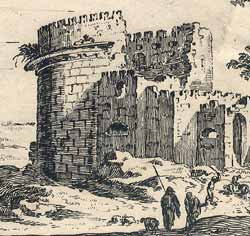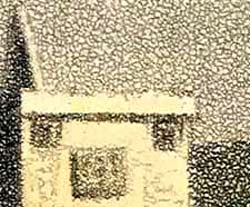|
TYPES OF PRINTS: INTAGLIO

If a scratch or groove is made into the surface of a copper plate, ink applied to it will lie in the groove. A piece of paper pressed onto the copper will then take up the ink. This discovery lead to the most important and long lasting group of printing techniques. This method of printing is therefore exactly opposite to the relief processes.
The different techniques allowed the development of prints showing the most astonishing virtuosity. It’s probably trite to say it, but if this range of printing processes had not been developed, there would be no prints as we know them today. The method is over 500 years old, having first been developed in Italy in the 1440s. The word Intaglio is Italian for engraving or incising.
Copper plates were the medium through which most prints were made. Copper was used as it is strong but still relatively easily worked. It does not rust, which would have been another advantage. In the 19th Century, steel plates started to be used.
A characteristic of all intaglio processes is the need to use a strong printing press, as much pressure needs to be exerted on the copper plate to ensure transfer of the ink. This leads to an important characteristic of the intaglio print – the impressed platemark, where the outline of the copper plate has pressed into the paper.
Our image of ‘Stella’ shows an original copper plate, published in London in 1810 by H R Cooke. The image has been worked as a stipple engraving, with line engraving used for the surround. This is quite a small plate, of overall size 138mm x 190mm.
ENGRAVING With this technique, a groove is cut into the surface of the plate with a small hand tool called a ‘burin’. A long sliver of copper is literally removed from the plate. The engraver creates the image by steadily creating more and more grooves. By varying the depth of the groove, the amount of ink taken up is also varied, leading to the printing of different line widths.
 Engraving is very skilled work, requiring much training and is also slow. Nevertheless, it produces a crispness of line and neatness in the print not possible with other processes. These characteristics give engraved plates a very controlled, regular feel. Engraving is very skilled work, requiring much training and is also slow. Nevertheless, it produces a crispness of line and neatness in the print not possible with other processes. These characteristics give engraved plates a very controlled, regular feel.
ETCHING The hard work and training involved in engraving led to the invention of the etching process. Copper is easily attacked by acid. To etch a copper plate, it is first coating in wax. Then, a drawing can be made through the wax with any pointed instrument. This has the effect of removing the wax and exposing the copper surface. When this is placed in an acid bath, only the exposed lines are attacked or etched.
Etching rapidly became a popularly used process. It would not be quite true to say that anybody could etch a plate, but it certainly meant that many artists could work up their own drawings into prints. The etched line is generally much softer than the engraved line, and allows a much freer appearance to the picture. work up their own drawings into prints. The etched line is generally much softer than the engraved line, and allows a much freer appearance to the picture.
In practice, both techniques were frequently used on the same plate. Etching might be used for most of the drawing work, then engraving to strengthen and firm up parts of the image. It can be difficult to tell when one process stops and the other starts.
Trying to rigidly divide prints into ‘etchings’ and ‘engravings’ is therefore not very realistic. In our prints for sale section, where the predominant feel of a print is of engraving, we class it as an engraving, and the same for etching. But from our period, it’s rare to find a plate that does not mix the techniques

The limitation of straightforward line engravings and etching is that they do not convey tones very well. This is especially important in representing faces and bodies. There are no ‘hard lines’ to our faces and bodies (well, not many!!), so representing them with lines will always seem a bit artificial. This led artists and printmakers to experiment with tonal techniques. There are quite a few variations to these, and again how they could be combined , but the main ones were:
AQUATINTS The aquatint is really a variation on the etching method, and one that proved ideal for landscapes. It can be described as a method of allowing tonal values to be developed through the etching process. As with the etching, the plate is coated, but this time to create a granular surface, through which the acid can work.
One common technique was to use powdered resin, which was sprinkled over the plate then heated to fuse it to the plate. Then, the engraver would control the rate of etching by ‘stopping out’ areas of the plate by painting them with varnish. The aquatint process enjoyed great popularity from around 1770 until abo ut 1830, after which it was largely superseded by lithography. ut 1830, after which it was largely superseded by lithography.
This small sample area has been deliberately chosen, as it’s a very crude example of aquatinting! You can see darker and lighter areas from the etching process and also clear areas which have been varnished to stop any etching.
STIPPLE ENGRAVING With this technique, thousands of tiny dots or punch marks are made into the copper plate. The density of the dots and their size will cause a different take up of ink, so giving a much better impression of tone. The method can be carried out by etching or punching directly into the plate. The technique was very popular in England from around 1770 to 1810.
MEZZOTINT Surely the king of the tonal processes! The mezzotint enabled virtually a photographic appearance to be created.
The mezzotint is prepared in quite a different way to the other processes described so far. First of all, the copper plate has to be specially prepared. This was done by making indentations across the whole surface of the plate. As each indentation or pit takes up ink, a first print off from the plate would  produce an entirely black print! produce an entirely black print!
The preparation was done with a roulette or rocker, which had scores of tiny steel points. The tool was ‘rocked’ over the surface scores of times, until the whole surface was completely evenly covered in pits.
Then to prepare the image, the printmaker actually scraped away the surface of the copper. The degree of scraping would decide the lightness of tone, until finally if all the pits were scraped off, that area of the plate would print as pure white.
The mezzotinting process although invented in the 1650s reached its greatest height in England in the period from 1750 to 1800, when it was used especially for portraits. The quality of a good early impression mezzotint is superb. The downside of mezzotinting is that the plate does not last very long, for the depth of the pits was very shallow and a few dozen impressions could wear a plate out. The printer would often keep printing them however, reworking the plate, so later impressions are often lighter and coarser.
email ross@georgianprints.co.uk
|